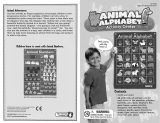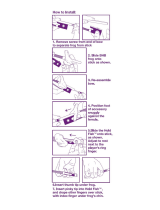Page is loading ...

EI-1741
Ages 4+/Grades Pre-K+
Contents
• Cloth wall chart
• 55 embroidered animals:
1 bear 6 frogs
2 pigs 7 fish
3 rabbits 8 ducks
4 dogs 9 sea stars
5 ladybugs 10 butterflies
Sort the Animals
Mix the animal pieces together and have children work to sort all
the same species together.
Animal Adventures
Encourage children to use the animals to tell progressive number
stories. For example, “Once upon a time there was one bear. One
day, the lonely bear was roaming the forest when he met two
happy pigs. ‘Where are you going?’ roared the bear. ‘We are
going t
o visit our friends the three rabbits,’ oinked the friendly
pigs. ‘Would you like to come, too?’” etc.
Children learn the alphabet with Animal Alphabet.
EI-1740 Animal Alphabet Activity Center
© 2008 Educational Insights, Inc., Rancho Dominguez, CA (USA).
Learning Resources, Ltd., King's Lynn, Norfolk (UK).
All rights reserved. Conforms to ASTM F 963.
Made in China. Please retain this information.
CUSTOMER SERVICE: (800) 995-4436 Monday–Friday
WEBSITE: www.Educational
I
nsights.com
1741 guide.qxp 11/9/07 9:00 AM Page 1

Children attach the self-stick animals to the chart to practice
matching numbers and sets, counting, comparing numbers, and more.
Before You Begin
Introduce the chart to your class — reviewing the names of the
different animals — bear, pig, rabbit, etc. Ask children to describe
each animal, including its color, where the animal lives, the sound
it makes, what it eats, and any other information children may
know about it.
Activities
Just the Numbers
Display the chart without the animals in place so children can
focus on the numbers and their names. Point to each number in
sequential order and have children say its name. Then quiz
children by pointing to the numbers in random order. If you wish,
use the chart with the familiar nursery rhyme below to reinforce
the number names in a fun way.
Numbers and Sets
Display the chart with the animals in place. Review each number
in sequential order, one at a time. Say the number name and
count the number of animals associated with it. Then quiz
children, asking them to identify the number of animals:
“How many dogs are there?”
“How many fish are there?”
“How many sea stars are there?” etc.
Then remove the animals, let children count each group, and
then have children place them next to the correct numbers. For
young learners the animals and numbers are color-coded to
provide visual clues.
More and Less
With the animals in place on the
chart, work with children on
comparing number quantities.
Ask questions such as:
“Are there more rabbits or butterflies?”
“Are there more frogs or ducks?”
“Which is more — seven or eight?”
“Which is less — six or five?” etc.
Simple Addition and Subtraction
With the animals in place on the chart,
work with children on simple addition
and subtraction problems. For example:
“There are ten butterflies. If five
butterflies fly away, how many
butterflies will be left?” Have a child
come up, count the butterflies, remove
five, and count the remaining butterflies
to solve the problem.
Number Riddles
Tell children you are thinking of a secret number. You will give
them clues, and they will try to guess the number. Here are
some examples:
“I am thinking of the number that comes after three.”
“I am thinking of the number tha
t comes before eight.”
“I am thinking of the number tha
t comes between seven
and nine
,” etc.
If children are having a hard time solving
the riddles, you can include the animal
associated with the number. For
example, you might say, “I am thinking
of the number that comes after five.
Frogs are hopping next to it.”
One, Two, Buckle My Shoe
One, two
, buckle my shoe.
Three, four, shut the door.
Five, six, pick up sticks.
Seven, eight, lay them straight.
Nine, ten, a big fat hen.
Let’s get up and count again!
Are there more frogs
or ducks?
If five butterflies fly away,
how many will be left?
1741 guide.qxp 11/9/07 9:00 AM Page 2
/












